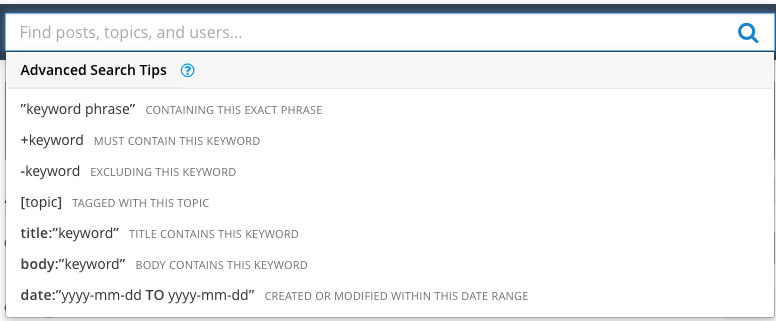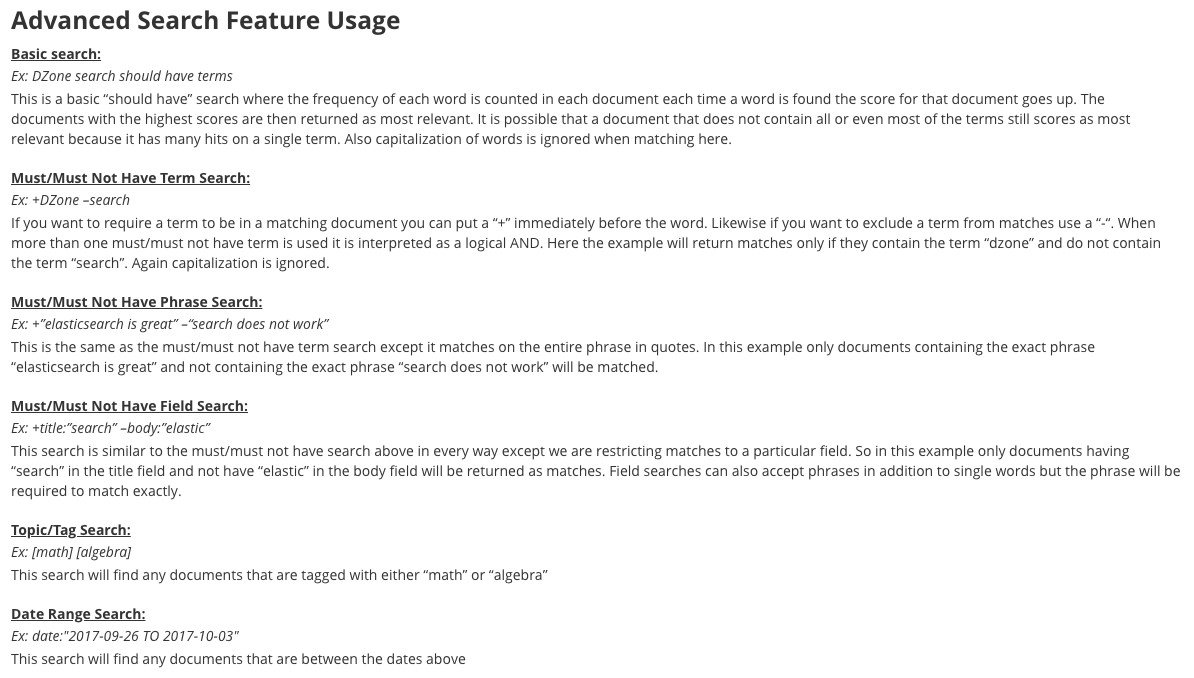Describing the AnswerHub Platform
Index "Home" page
Newsfeed displaying recent activity throughout the community across all spaces and content types that your user has access to.
Navigation bar
The navigation bar consists of the following:
- User Avatar
- User Profile
- Navigation Widget (Vertical Tree Diagram)
- Search Bar (Elasticsearch Services)
User avatar
The options displayed in a user's personal drop-down menu are dynamic and will differ based on their level of community access. For example, some users will see a Moderation and/or Administration option. All standard users will see the Profile, My Preferences, and Logout options.
User Profile
The user profile provides an array of details about the user, along with their activity and status within the community. You can view a user's overall status by looking at both aspects of our gamification. This includes badges earned and the total number of reputation points accumulated throughout their community lifetime.
- Reputation Points: A users' level of reputation displays on their profile. This number represents the earning of points which users gain/lose for various interactions and contributions within the community.
- You can leverage reputation points within permission settings to temporarily prevent a user from performing some action until they reach a specific threshold of reputation points.
- Keep in mind that we attribute earning reputation points for various interactions to four primary methods:
- Reward user: This method acts as a debiting system. If I give you two points, I lose two of my points. By debiting and crediting we prevent over-rewarding to gain additional capabilities within the community if there are some permissions set by the reputation X option.
- Admin give/take reputation: This method is similar to printing money. We do not deduct points from the admin's account like they are when a user manually rewards reputation points to another user directly on a post. If a community admin goes to a user profile, one option in the edit drop-down menu is to give/take reputation. Entering a 1 will give a point, entering a -1 will take a point. You can add "n number" of points and take away "-n number" of points.
- Default Reputation & Reputation Gains/Losses: Accessed by navigating to Site > User Engagement > Default Reputation Levels or Reputation Gains/Losses. The default reputation page displays all the default reputation points for specific actions. The Reputation Gains/Losses page allows you to control how you reward or penalize users for specific actions.
- Idea related reward: Based on the lifecycle stage accessed by navigating to Content > Node Structure > Idea Workflow. On this page, you can create new states and configure existing states. State appearance, workflow rules, votes and reputation based on states are all configurable.
- Favorite: A star icon displays for all three main content types (Questions, Ideas, and Articles). When clicked, the post marks as a favorite. Favoriting a piece of content acts as a bookmark. This allows you to navigate to your user profile at a later date, view your favorites, and refer back to any previously saved posts.
- My Subscriptions: Users have the ability to follow various objects within the community. This includes Topics, Questions, Ideas, Articles, and Spaces/Sub-Spaces.
TIP:If you follow a decent number of objects, you may receive more notifications throughout the day than you'd like. If that's the case, no need to unsubscribe. AnswerHub provides a lengthy list of options for the type and frequency of notifications. Update your notification preferences to daily or weekly digests so you can remain in the loop and engaged in a more manageable way.
- You can update these settings by navigating to the My Preferences option in your personal drop-down. You can also access by clicking Profile, then Edit then selecting Email Notification Settings, then navigate to the Notifications tab.
Navigation Widget (the vertical tree diagram)
- Topics: By default, we sort them by popularity, but you can also sort them alphabetically. We note the number of times users have interacted with the topic beside each topic.
TIP:If your team is auditing your topics list for routine clean-up, sort them alphabetically to see if there are any duplicate topics to merge. For example, you should merge topics such as "sale", "sales", and "sales department" (discussed more in the Admin Console UI Relevant to Moderators section in 101 Managing your Community as a Moderator).
- Questions: This displays a list of questions that users have asked. The default display is All Questions but you can select either Unanswered Questions or Recommended Questions from the drop-down next to All Questions.
- Your team can determine what an unanswered question means to you. There are two configurations in the admin (Content > Node Structure > General Settings) that allow you to treat "unanswered" as questions without accepted answers in this queue, and/or to exclude questions from the unanswered list that have been "closed" regardless of whether or not they have an answer.
- Articles: Displays all articles across spaces/sub-spaces within your community that your user has access to.
- Ideas: Displays all ideas across spaces/sub-spaces within your community that your user has access to.
TIP:If you click on the lifecycle stage label next to an idea, you're brought to a filtered list view of all ideas within the community are currently in the same stage.
- Users: All users within the community will display in a tile view with five sorting options you can apply. Each tile displays a few insights into a user's community standing.
- Diamonds: If they are a super user and/or moderator you will notice one or two diamonds appear next to the username.
- Numbers: From left to right, the numbers shown represent the user's total number of reputation points, gold, silver, and bronze badges they have earned.
TIP:If your team has enabled our leaderboard plugin, we alter this view to show more of a ranking chart based on users earn/loss of reputation points within the available time frame filters.
- Badges: AnswerHub's gamification consists of two aspects: reputation points and badges. We offer a default set of badges we break down into three levels: bronze, silver, and gold. Users can earn each badge through various interactions.
- You can customize badges, however, it requires using our SDK to implement changes. Depending on the extent of your desired changes, the amount of work and technical experience needed to implement changes can vary.
- Spaces: Use these to organize your community as they are the top-level categories in which content lives. Anytime a user is posting content, they must select a space to post it in. Because of this, admins leverage spaces to control the visibility/access to various areas within your community.
- You can create a hierarchy within your spaces by creating a child, also known as a sub-space. There is no limit to the number of levels you can implement within your space structure.
- Create Button: This button is dynamic, so depending on the permissions set for your user, the options displayed may vary. All options are as follows: Create a Question, Article, or Idea.
TIP:Our customer success portal is a great example of this. If you navigate to the Feature Request space, you'll notice that your only option is to post an idea. We've eliminated all potential user errors by only allowing users to create the content we want in that specific space.
Search Bar
The golden rule of AnswerHub is to search first and ask later. Our search indexes throughout all major nodes. This includes Questions, Answers, Comments, Ideas, Articles, Users, and Topics.
- As you type, AnswerHub will start to index throughout all nodes that your user has access to (Questions, Answers, Comments, Articles, Ideas, Topics, and Users).
- Offers type-ahead suggested results to prevent duplicate efforts for both end-users and community moderators.
- Start typing in the Search bar to see all the available search operators and Advanced Search Tips in a drop-down list.


- Shortcut to create a question if your search completed with no recommended results.
- Refine your search: By performing a search with at least one word (pressing enter or clicking the magnifying icon) you can then further refine your results using the following:
- Posted (timeframe in which a user originally created the content)
- Within space
- Authored by
- With topics
- Content type
- Refine your search: By performing a search with at least one word (pressing enter or clicking the magnifying icon) you can then further refine your results using the following:
Updated about 1 month ago
